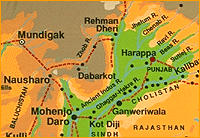 The Harappa site was first briefly excavated by Sir Alexander Cunningham in 1872-73, two decades after brick robbers carried off the visible remains of the city. He found an Indus seal of unknown origin.
The Harappa site was first briefly excavated by Sir Alexander Cunningham in 1872-73, two decades after brick robbers carried off the visible remains of the city. He found an Indus seal of unknown origin.
The first extensive excavations at Harappa were started by Rai Bahadur Daya Ram Sahni in 1920. His work and contemporaneous excavations at Mohenjo-daro first brought to the world's attention the existence of the forgotten Indus Valley civilization as the earliest urban culture in the Indian subcontinent.
His work was followed later in the decade by that of Madho Sarup Vats, also of the Archaeological Survery of India. M.S. Vats first excavated the "Granary," and published the results of his and Sahni's excavations in 1940. Excavations by other archaeologists continued in the 1930's, and in 1946 Sir Mortimer Wheeler excavated the so-called fortification walls and found the first pre-Indus Valley civilization (Kot Dijian) deposits.
After independence, Harappa was excavated by Mohammed Rafique Mughal of the Archaeological Survey of Pakistan in 1966. In 1986, the first systematic, multi-disciplinary excavations of an Indus Valley city were begun by the Harappa Archaeological Project (HARP), under the direction of George F. Dales and J. Mark Kenoyer. These excavations, now also co-directed by Richard H. Meadow, have continued almost every year since then.
There is an enormous amount still to be learned about the site, most of which remains unexcavated. The earliest deposits on the site go back to 3300 B.C. and the area seems to have been continuosly inhabited ever since. Archaeologists think that ancient Harappa was the urban center dominating the upper Indus region, much like Mohenjo-daro dominated the lower Indus Valley and Ganweriwala might have been the urban center for what is now Rajasthan.
